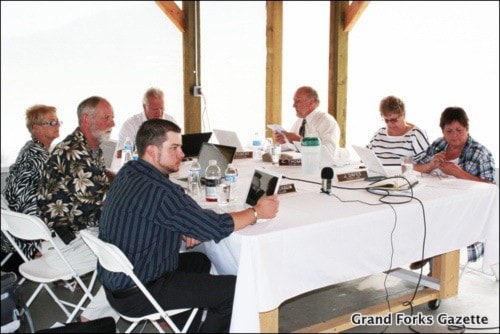With the City of Grand Forks looking to borrow millions to fund infrastructure upgrades, fire protection and roads have been listed as priorities.
Council gave three readings to two bylaws at Monday’s meeting, one that would authorize the borrowing of up to $1.3 million for emergency water supply for fire protection (Bylaw 1922) and another that would authorize upwards of $4.2 million for road, water and sewer capital renewal projects (1923).
Infrastructure was also a topic at a special meeting on July 11, in a presentation made by City Chief Financial Officer Cecile Arnott and Michael Trickey from Urban Systems Ltd. detailing an asset management financial plan for Grand Forks.
“We had Mike Trickey to present the whole package to us with his analysis of where we should start,” explained Mayor Brian Taylor.
“Council had a decision on how big a (financial) bite we would take and over what period of time we would do it and that is where this is coming from.”
The mayor said that Bylaw 1922 was particularly exciting because the cost would be much less for water supply for fire protection due to creative problem solving – the $1.3 million is a far cry from a previous $4.5 to $6 million plan to establish a reservoir atop Hardy Mountain.
“The new approach of putting generators at each of our pump stations and drilling an extra well with another generator set will allow us to use our wells as reservoirs for keeping the water pressure up for the fire system so that we’re able to do without building a large reservoir by using the new technology and our existing wells,” Taylor said.
“The SCADA (supervisory control and data acquisition) system that we use will allow us to monitor and control the wells and our fibre optics will allow us to do it from a single office rather than running around in an emergency trying to balance off the water pressure from each well.”
Taylor said that Bylaw 1922 was a combination of creative thinking, new technology and thinking outside the box.
Regarding the $4-million-plus for roads, the mayor said that roads were the city’s biggest infrastructure deficit.
“We want to tackle roads; it’s a big one,” Taylor said.
“The $4.2 million for roads will address a number of high-priority areas where there are multiple services in the ground that we can do all at once. It’s also looking at some items that will be preventative maintenance, so that we may be looking at paving certain stretches of highway where we can retain the surface and avoid having the base deteriorate.”
In the upcoming civic election, there will be a referendum and whether to borrow for infrastructure upgrades will be amongst the questions being asked.
“When we borrow money, we ask the people if they agree and we go by referendum and they vote,” Arnott explained.
“Before we go to referendum, we have to go to the inspector for the province and they approve the loan authorization bylaw. The reason we have to do it and send it in is because we have to hear back from the inspector and we can go out in September and start to talk to people about asset management and what that looks like.”
She said that in order for that to happen, the city needs to know that the province will give the OK.
“We’re just doing our due diligence,” Arnott said.
